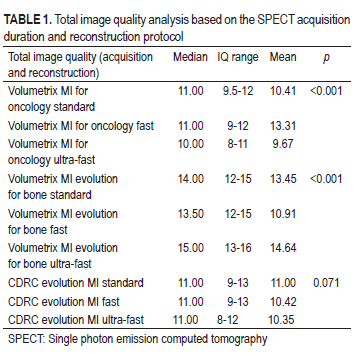Optimisation of the bone single photon emission computed tomography in oncology patients
DOI:
https://doi.org/10.17532/jhs.2023.2596Keywords:
Single photon emission computed tomography, signal-to-noise ratio, contrast-to-noise ratio, RRAbstract
Introduction: The introduction of hybrid imaging systems such as Single Photon Emission Computed Tomography/Computed Tomography (SPECT/CT) has completely changed the scanning procedure of conventional diagnostic nuclear medicine protocols. Modern bone scintigraphy protocols include SUV quanitification and Whole Body (WB) SPECT/CT scanning modality. The major limitation of these new technologies is relatively long scanning time. New detector systems with modern reconstruction softwares have been developed for fast scanning SPECT protocolos. These new technologies can produce images of reduced acquisition with same quality as full scanning acquisition. As a result new studies suggest that planar WB scintigraphy should be replaced with WB SPECT/CT.
Methods: One hundred oncology patients performed SPECT/CT as a part as their clinical follow-up. Three different scanning and three reconstruction protocols have been evaluated. Two nuclear medicine physicians evaluated with Likert scale image sharpness, lesion visibility, and lesion background detectability. The overall image quality was determined as the sum of these three parameters.
Results: In terms of scan duration reduction on image quality, Volumetrix Evolution for Bone performed during ultra-fast SPECT acquisition achieved the highest score, which is superior compared to the standard SPECT acquisition protocol. The overall image quality was the best with the Volumetrix MI Evolution for Bone protocol for ultra-fast acquisition
Conclusion: The Evolution for Bone protocol for ultra-fast acquisition showed best results compared to other protocols. The adoption of new acquisition SPECT protocol may offer more comfortable exams, resulting in higher patient satisfaction. The implementation of this new protocol can lead to an improvement in SPECT sensitivity, primarily due to the reduction of SPECT motion artifacts.
Downloads

Downloads
Published
License
Copyright (c) 2024 Nusret Salkica, Amela Begić, Adnan Beganović, Fuad Julardžija, Adnan Šehić, Halil Ćorović, Safet Hadžimusić; Amra Skopljak-Beganović

This work is licensed under a Creative Commons Attribution 4.0 International License.










